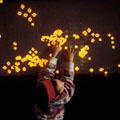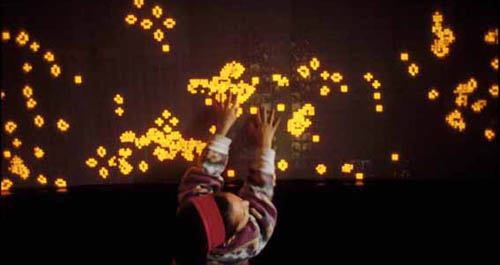







|
|
|
Life
The second experiment, named after the famous "Game of Life"
invented by John Conway, involves a colony of molecules. Each
molecule's existence depends on the number of living neighbours
it has. The visitor can give life to the molecules and observe
the evolution of the colony.
|

|
Life : When complexity suddenly appears from nothingness, or the surprises of
emergent behaviour
|
Life is complexity. The way a spider weaves its web or
an ant colony builds its nest suggests that these creatures
are intelligent. They are nothing of the sort. Biologists have
demonstrated that, by blindly following basic rules that have
been gradually developed through natural selection, every animal
behaves in ways which are sometimes extremely complex.
In the world and language of computer science, the appearance
on the screen of complex motifs generated by simple rules is
known as "emergent behaviour". In the Life experiment, each
BioWall molecule is either dead (dark) or alive (lit up). Every
second, each molecule gains a new status (either dead or alive),
which depends solely on the number of living molecules within
its immediate vicinity. A colony of living molecules then forms
a motif which either becomes distorted with time, grows and
aggressively colonizes the space or, on the contrary, gradually
disappears. Visitors can help this artificial population to
survive by pressing a dead molecule, thus reviving it and changing
the colony's collective behaviour at local level. |
|
Instructions for use
The current BioWall prototype has a surface of
2,000 molecules, each one either dead (dark) or alive (lit up).
Whether a molecule survives depends only on the status of its
eight immediate neighbours (figure 1) and on the following rules:
- if the number of living neighbours is too small (zero or one), the molecule dies of isolation and its future status is "dead";
- if a molecule has exactly two living neighbours, it survives and its current status, either "dead" or "alive", is unchanged;
- if a molecule has exactly three living neighbours, a new molecule is born and its status is "alive";
- if a molecule has too many living neighbours (four or more), it dies of overpopulation and its status is "dead".

Figure 1: Rules of the "Game of Life" (red = alive, black = dead).
|
Molecule colonies
You will notice that some motifs are stable, eg the square (figure 2). Some, such as the blinker, form a cycle,
while others move around without changing shape, eg the glider.

Figure 2: Various motifs from the "Game of Life".
|
Behind the scenes
The emergence of complex motifs from simple rules is a characteristic of very popular computer structures known as "cellular
automata". Mathematician John Conway devised the "Game of Life" in accordance with the aforementioned rules.

For further information
- E.R. Berlekamp, J.H. Conway, R.K. Guy: Winning Ways for your Mathematical Plays. Vol.2: Games in Particular.
Academic Press, London, 1985.
Resources
|
 |
Children playing with Life.
© Eurelios
35KB JPEG |
|
|
|
|

